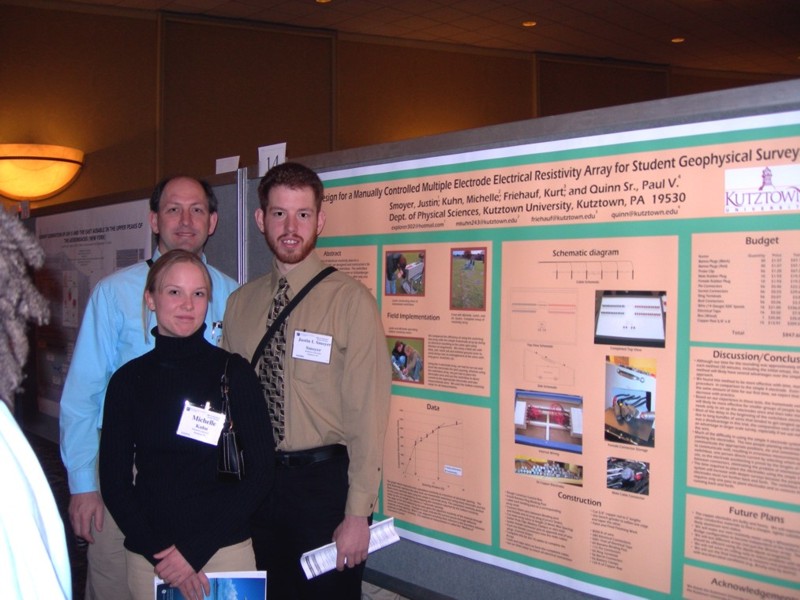
 Design
for a manually controlled multiple electrode electrical
resistivity array for student geophysical surveys
Design
for a manually controlled multiple electrode electrical
resistivity array for student geophysical surveys
Smoyer,
Justin, Kuhn, Michelle, Friehauf, Kurt,
and Quinn,
Paul V. Sr., 2006, Design
for
a manually controlled multiple electrode electrical resistivity
array for student geophysical surveys [abs]: Geological
Society of America Northeastern Section – 41st Annual Meeting (20–22
March 2006), Harrisburg, PA, Program with Abstracts, v. 38, no. 2,
p. 89.
 To facilitate rapid collection of electrical
resistivity data for a groundwater study in karst terrain, we
designed and constructed a 56 electrode array controlled with a
manual switching box. The switchbox allows directing current to
electrodes using Wenner or Schlumberger arrangements for vertical
sounding on several centers after only one emplacement of electrodes
or Dipole-Dipole arrangements for measuring pseudo-sections.
To facilitate rapid collection of electrical
resistivity data for a groundwater study in karst terrain, we
designed and constructed a 56 electrode array controlled with a
manual switching box. The switchbox allows directing current to
electrodes using Wenner or Schlumberger arrangements for vertical
sounding on several centers after only one emplacement of electrodes
or Dipole-Dipole arrangements for measuring pseudo-sections.
The rate of data collection improved most with longer node spacing
and when operated by fewer students because moving the electrodes
was the slowest step in the data collection procedure. Results of
data for the same test site using traditional four-electrode Wenner
array to determined depth to the base of the plow zone and depth to
bedrock are virtually identical to those measured with the big array
(R-squared = 0.99).
The spacing between electrodes is 3 meters, allowing a maximum
spacing with the Wenner array of 55 meters. Data analysis using a
spreadsheet helps students understand the concepts underlying their
data interpretation. For undergraduate student hydrogeology
projects, the instrument is a low cost alternative to commercial
multi-node arrays and all materials are readily available.

 Design
for a manually controlled multiple electrode electrical
resistivity array for student geophysical surveys
Design
for a manually controlled multiple electrode electrical
resistivity array for student geophysical surveys

 Design
for a manually controlled multiple electrode electrical
resistivity array for student geophysical surveys
Design
for a manually controlled multiple electrode electrical
resistivity array for student geophysical surveys
 To facilitate rapid collection of electrical
resistivity data for a groundwater study in karst terrain, we
designed and constructed a 56 electrode array controlled with a
manual switching box. The switchbox allows directing current to
electrodes using Wenner or Schlumberger arrangements for vertical
sounding on several centers after only one emplacement of electrodes
or Dipole-Dipole arrangements for measuring pseudo-sections.
To facilitate rapid collection of electrical
resistivity data for a groundwater study in karst terrain, we
designed and constructed a 56 electrode array controlled with a
manual switching box. The switchbox allows directing current to
electrodes using Wenner or Schlumberger arrangements for vertical
sounding on several centers after only one emplacement of electrodes
or Dipole-Dipole arrangements for measuring pseudo-sections.